Pull up any major news outlet and you’ll surely see it: supply chain disruptions are still ongoing on a global scale. For manufacturers all over the world, supply chain issues present a major threat to productivity and their ability to meet critical business deadlines.These ever-persistent supply chain issues continue to antagonize businesses of all types and sizes, manifesting as anything from a tequila drought at your local bar to medical supply shortages, to companies like Apple leaking billions at the hands of chip shortages. The expert prognosis is that external supply chain issues are likely here to stick around for the foreseeable future.
However, by bringing in a fast and reliable professional 3D printing platform, manufacturing businesses can bypass many of these risks — while also making their supply chains tighter and more efficient than before, with full control.
So, how specifically are companies using 3D printing to solve supply chain issues, while reinventing their supply chains to be more efficient and less disruptable than ever? Read this article to learn how, with 5 real-life examples — organizations from the U.S. Army to manufacturers of aircraft parts and wind turbines.
How does 3D printing build resilient supply chains?
Supply chain issues for manufacturers
For manufacturers, supply chain issues can create a number of major problems. Suboptimal supply chain logistics can create lead times that hinder growth and compromise the ability for businesses to meet critical deadlines. If a critical part needs to be replaced in the factory, manufacturing operations can easily stall for however long it takes for the part to be built, shipped, transported, and received — oftentimes, this is in the range of months.
For organizations who rely on third party external suppliers to manufacture supply chain-critical parts, there is substantial time and effort between when a company first identifies a need, and when the final part arrives. Engineers must spend time drafting drawings, submitting purchase orders, and managing the bidding process with multiple vendors. Even once the third party finishes fabricating the parts, they then must be shipped out to the specific sites where they are needed.
Serious delays can arise from a hiccup in any point in this process — such as shipping or handling complications, or an upstream supplier experiencing a material shortage. If the received parts contain defects or other quality issues, this long, arduous cycle must be repeated, which can lead to extended downtime or other serious business consequences.

Tools for supply chain risk management
3D printing platforms can allow manufacturers to circumvent these hurdles and uncertainties. With a cloud-enabled distributed manufacturing model, the right parts can be quickly printed at the precise locations where they are needed, when they are needed. Individual printers can be placed across different geographic locations. Due to 3D printing software, parts stored in a cloud-based digital inventory can then be sent to be printed at any 3D printer within the network.
With just a CAD file, manufacturers can go from art to part entirely in-house — eliminating dependence on third parties and the associated risks, such as shipping issues, logistical complications, and issues with upstream suppliers that cause rippling effects.
By effectively bypassing certain steps of traditional supply chain logistics — such as the common need to receive shipments to obtain parts — 3D printing trims off the associated risk for supply chain disruptions. For parts that must be machined, using an AM system for rapid prototyping will help engineers ensure that when the machined part is finally received months later, it will work as expected.
Julie Van Der Hoop, Product Manager at Markforged, explains how 3D printing software makes it possible to send 3D printed parts to the exact point of need, at the precise time of need. Distributed manufacturing eliminates the need for expedited shipping and complicated supply chain logistics.
Combating supply chain disruptions with disruptive technologies
As additive manufacturing continues to move forward and expand in capabilities, 3D printing is able to solve an increasing number of major supply chain issues.
Worried about the aluminum shortage jacking up the prices? No problem — today’s professional 3D printers can make composites stronger than aluminum, in anywhere from just hours to days. Due to distributed manufacturing powered by cloud-based manufacturing networks and 3D printer connectivity to Industry 4.0 technologies, print jobs can be initiated by an operator from halfway across the globe and have it appear at the exact point of need.
The strength and material properties of today’s continuous fiber-reinforced (CFR) composite parts make it a faster, cheaper, and easier replacement for almost any part — even parts that must meet the demanding needs of the most specialized applications. These high-performance composites can replace many parts that were previously made from machined metals.
For parts that must be made from metal, metal fused filament fabrication (FFF) technology makes metal 3D printing more accessible, safer, and more simple for everyday use compared to other metal 3D printers — which are more expensive, have handling difficulties and safety risks associated with use of loose powder, and require highly trained operators.
“We provide the physical article in near real-time to a variety of places. It’s the closest thing to teleportation I think you can get.”
– Jeremy Haight, Principal Engineer for Additive Manufacturing & AdvancedConcepts at Vestas
1.) Vestas
Vestas, based in Denmark, is a global wind energy leader that designs, manufactures, installs, and services wind turbines across the globe. With wind turbines located in 86 countries, Vestas is the world’s largest on and offshore manufacturer of both wind turbines and wind turbine blades. Vestas operates out of over 15 manufacturing plants worldwide.
In Corporate Knights’ Global 100 ranking of the 100 most sustainable corporations, Vestas was ranked first. The company is using additive manufacturing for sustainability in its goal of net-zero decarbonization by the year 2030, and plans to produce zero-waste wind turbines by 2040.
Get to know Vestas, and see how they use Markforged 3D printers to circumvent supply chain issues.
Supply Chain Challenge:
For Vestas, many critical tools and parts are needed at each manufacturing facility and installation site. Tools like inspection gauges are needed to ensure precision and accuracy in the manufacturing and installation processes. Vestas has no room for error during manufacturing and installation: wind turbines are expensive machines, and downtime can be costly.
Vestas historically has outsourced the manufacturing of many parts to multiple third party vendors around the world. Detailed manufacturing instructions would be provided for each part, such as the inspection gauges and top center (TC) marking tools. The finished parts would then be sent to Vestas’s manufacturing facilities and installation sites.
However, outsourcing manufacturing of critical parts created a few problems that ultimately led to delays in final product delivery and installation:
- Many of the final inspection gauges supplied by third party manufacturers were not 100% up to spec and did not pass final inspection.
- Manufacturing was time expensive and costly for the parts that did make it through the specialized inspection process. Lead times would average about 5 weeks for some parts, and a minimum of 12 weeks for others.
Supply Chain Solution:
Due to the strength and material properties of Markforged’s continuous fiber-reinforced (CFR) composite parts made with Onyx, many parts that were previously machined could be 3D printed on-site on a Markforged industrial 3D printer (X7) instead of using third party manufacturers.
Vestas turned to the cloud-based Digital Forge to solve these supply chain problems with additive manufacturing, and launched its direct digital manufacturing (DDM) program in 2021. With a network of 3D printers at Vestas’s many different sites, connected by Markforged Eiger™ 3D printer software, employees at any Vestas location — with little to no expertise in additive manufacturing — can easily access a cloud-based digital inventory of 2000+ Vestas parts.
Thanks to this digital repository, Vestas employees can print up-to-spec parts on a moment's notice, anywhere in the world, without the need for specialists. Printed using exact digital specifications with the accuracy of the Digital Forge, Vestas does not have to worry about parts failing compliance tests. Vestas can verify the accuracy of their tools during the fabrication process using Markforged Blacksmith™ software for in-process inspection, analysis, and reporting.
Manufactured lead times are dramatically reduced, from 5-12 weeks to just 1-2 days. Costs for each part were dramatically reduced, and ongoing shipping and freight costs were eliminated.
2.) U.S. Army
The U.S. Army’s Fort Irwin National Training Center is a major training base for the U.S. Army. Located in San Bernardino, CA, the NTC provides realistic joint and combined arms training to develop the U.S. Army’s soldiers and leaders for the battlefield. They train soldiers for upcoming deployments, wherever that may be in the world.
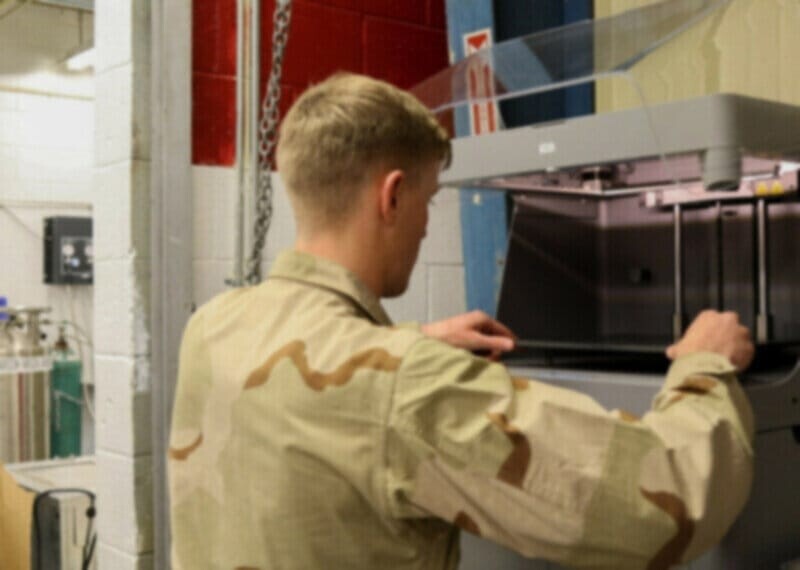
Supply Chain Challenge:
The Fort Irwin National Training Center requires many specialized resources, such as military-grade vehicles and equipment, to provide realistic battlefield training. The equipment receives a tremendous amount of wear and tear due to repeated use, as the NTC is constantly training new sets of soldiers for deployments.
If any part broke during training, it historically meant that soldiers would simply have fewer resources to use at the training center. Due to the Fort Irwin National Training Center being based in a remote location, replacement parts would carry lead times of up to 3 months.
A single part breaking could have severe ramifications on the quality of training for a squadron — even just a single component could render a piece of equipment or vehicle completely unusable.
Supply Chain Solution:
With metal 3D printing (Metal X system), a Markforged X3, and a desktop 3D printer (Mark Two), bringing additive manufacturing on-site to Fort Irwin through the Digital Forge has helped the Army NTC create readiness factors and maintain availability of equipment and vehicles to be used in training.
The U.S. Army’s Markforged composite printers have been used to print personal protective equipment (PPE), military vehicle parts (window wiper brackets, hatch plugs, and more), an assortment of tools, and other low-volume production parts.
One specific application has saved the U.S. Army $244,000 alone — hatch plugs that sit on top of vehicles, used in low-light scenarios to help the driver see at night. The hatch plug is a critical low-volume replacement part for a specific component that is not in production and no longer available anymore. Without in-house additive manufacturing, each hatch plug would cost roughly $10,000 to reproduce, and carry a 3-month lead time. On the Digital Forge, hatch plugs could be printed in Onyx for $230, or with 17-4PH Stainless Steel for $800.
3.) Automation Alley (Project DIAMOnD)
Automation Alley is a non-profit Industry 4.0 knowledge center based in Troy, Michigan. Their mission is to embrace the Fourth Industrial Revolution: helping local small to mid-sized manufacturers in Michigan scale up their Industry 4.0 activity to innovate, increase resiliency, and improve agility.
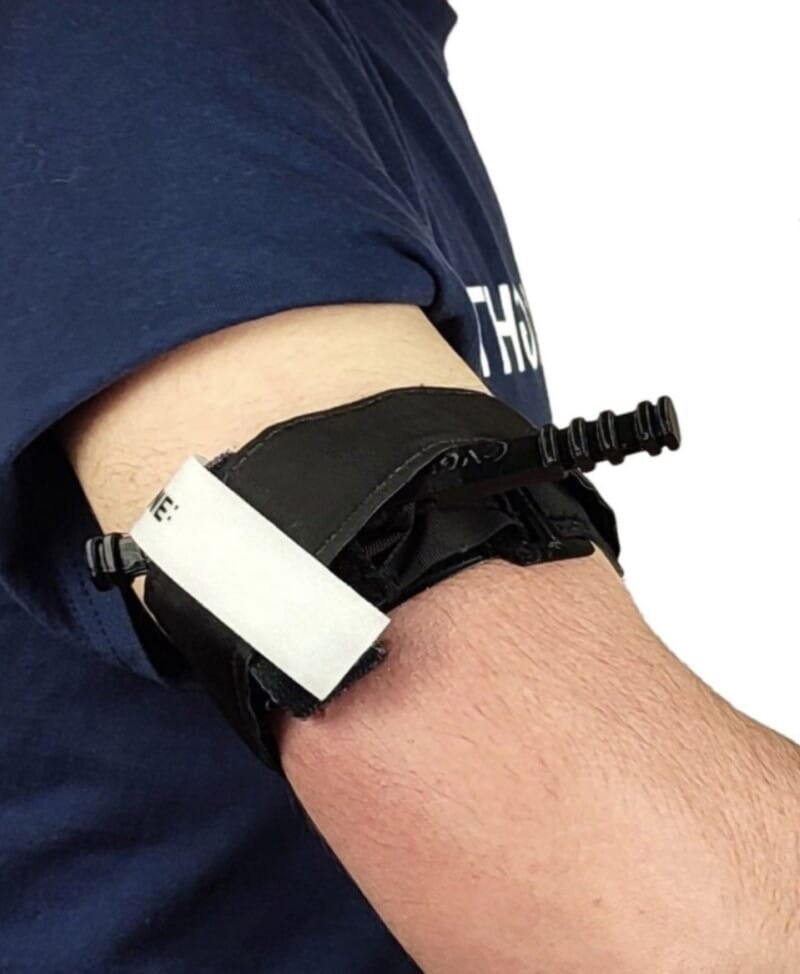 Final tourniquet using a 3D-printed Onyx clip. (source: https://3dprintingforukraine.com/)
Final tourniquet using a 3D-printed Onyx clip. (source: https://3dprintingforukraine.com/)
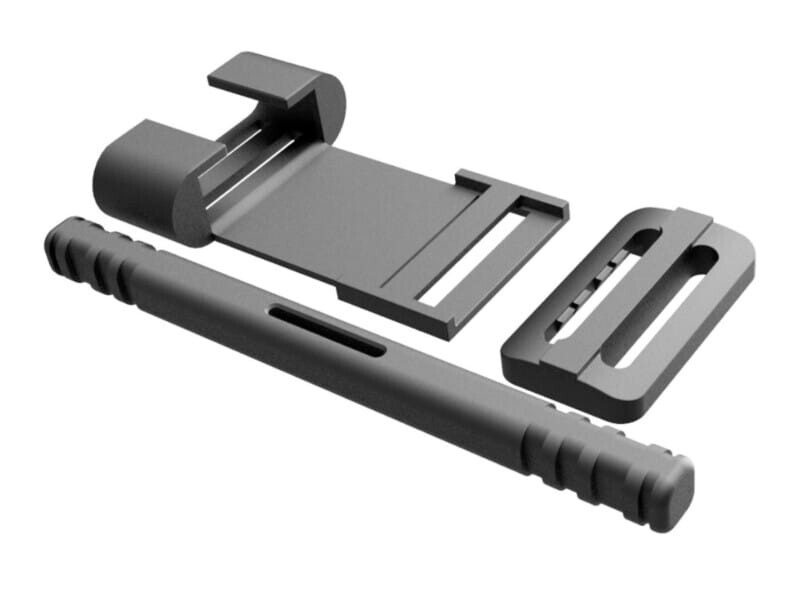 Tourniquet components, featuring 3D printed Onyx clip on top. (source: https://whatt.io/alphaone/ukr/04:c7:4d:8a:83:72:80)
Tourniquet components, featuring 3D printed Onyx clip on top. (source: https://whatt.io/alphaone/ukr/04:c7:4d:8a:83:72:80)
Supply Chain Challenge:
For a large portion of the ongoing global pandemic, efforts to mitigate COVID-19 have been hindered by critical gaps in the supply chain for personal protective equipment (PPE). With supply chain delays and shortages still ongoing in 2022, medical equipment has been nearly impossible to manufacture swiftly in response to any time-sensitive need.
Furthermore, in response to an acute need, timely production of medical equipment would not be possible through traditional manufacturing processes, which require tooling to be made before production of the final parts can even be initiated. Processes like injection molding would add weeks before the earliest steps of production could be started.
Supply Chain Solution:
Automation Alley, using grant funding from the CARES ACT in 2020 from Michigan’s Oakland and Macomb counties, was able to start the world’s largest distributed manufacturing network, which is known as Project DIAMOnD (Distributed, Independent, Agile Manufacturing on Demand).
The purpose of Project DIAMOnD is to improve local manufacturers’ agility and resiliency by helping them scale up their Industry 4.0 activity, while also creating a large-scale emergency response network for printing physical objects on demand. Supplying small to mid-sized manufacturers across Michigan with Markforged 3D printers, the manufacturers in exchange will print critical medical equipment (such as PPE for frontline healthcare workers) when called upon to do so.
In April of 2022, the emergency response network of over 300 Markforged printers was activated for the first time. The Project DIAMOnD network was used to mass produce tourniquet clips out of Onyx, which were then shipped overseas to aid Ukrainians in need of medical assistance.
Coordinating mass print jobs between over 300 3D printers sounds like a complicated and daunting task. However, 3D printing software using the Eiger Fleet API made it simple.
Eiger provides a digital repository for part files, and Automation Alley was able to instantaneously distribute the tourniquet clip design throughout the entire network, adding it to each printer’s queue with just the click of a button.
4.) Cabin Management Solutions
Cabin Management Solutions (CMS), based in Conroe, Texas, is an aerospace company that designs and installs cabin control and entertainment systems for luxury private and business jets. CMS works with aircraft maintenance, repair, and overhaul (MRO) companies and private owners to deliver these bespoke aircraft interior solutions.
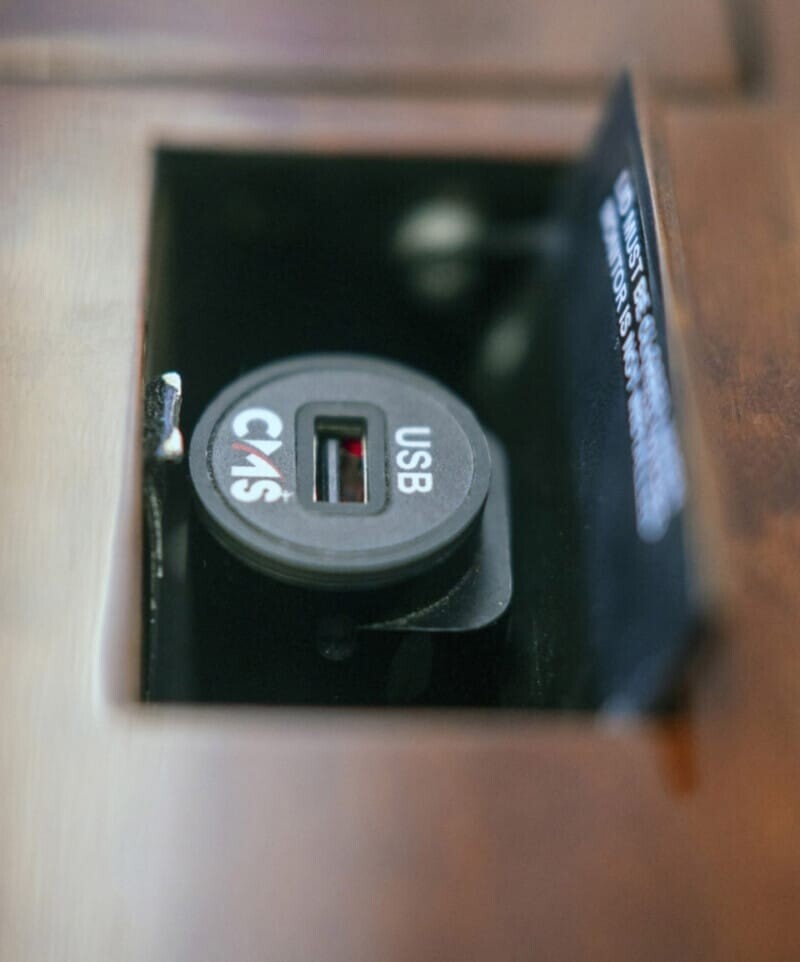
Supply chain challenge:
CMS was founded to provide a cost-effective, quick-turn alternative to the long lead times and high costs associated with cabin management maintenance, upgrades, and replacements within aircraft. However, many aspects of their business are quite time consuming, which can potentially stretch project timelines and extend customer lead times.
- Each custom one-off job is generally time consuming: parts must often be designed, manufactured, and fit into pre-existing aircraft layouts. With it being not uncommon for customer requests to change in the middle of production for these parts, CMS must still maintain the agility to make modifications on the fly — customers’ projects must be finished in a timely fashion to uphold their value proposition of fast lead times.
- With many of CMS’s repair and update jobs being on luxury jets, these projects often require specific parts and components that have been discontinued from production.
- For each part and material CMS uses in its projects, it must be thoroughly tested and traceable to quality for approval from the Federal Aviation Administration (FAA).
Supply chain solution:
Bringing in a Markforged X7 industrial 3D printer to produce the needed parts and components in-house, Cabin Management Solutions can now take on more jobs and increase the speed of completion for each individual project.
Printing in Onyx FR reinforced with carbon fiber on the X7, end-use parts can be produced quickly. Even for CMS’s visible applications where aesthetics are at the forefront of importance, parts printed from the X7 do not require additional post-processing.
“Other printers don’t generate as high quality a finish, leading to additional post-processing that the CMS team is able to avoid when using the X7.”
– Jeff Pike, VP of Engineering, Cabin Management Solutions.
Furthermore, Onyx FR is a certified UL 94 V-0 rated flame retardant material. Parts printed in Onyx FR are high-strength, low-weight, and bring the necessary flame-retardance to quickly achieve FAA compliance in every application.
In one particular project, CMS printed over 100 different parts on their X7 for a jet. The parts included adjustable touch screen brackets, light switch panels, USB-C and drop-in USB-A chargers, a cabin climate controller, latches, release buttons, and more.
5.) Nieka Systems
Nieka Systems is a Canadian manufacturer of borate fusion sample prep equipment for customers in the mining and cement production industries. Using Nieka’s machines, ore and cement samples can be fused into glass discs in preparation for precise compositional analysis, and to assist with quality control.
Nieka’s machines work by mixing and dissolving material samples in molten borate flux in a platinum crucible at temperatures exceeding 1000 degrees Celsius. These platinum crucibles are suspended over gas burners or electric heating elements by thin metal clips which connect the crucible to the machine. When the sample is fully dissolved in the flux, the machine upends the crucibles and pours the molten contents into a platinum mold to cool. Later the room-temperature prepared samples can be removed and analyzed via X-ray in a separate machine.
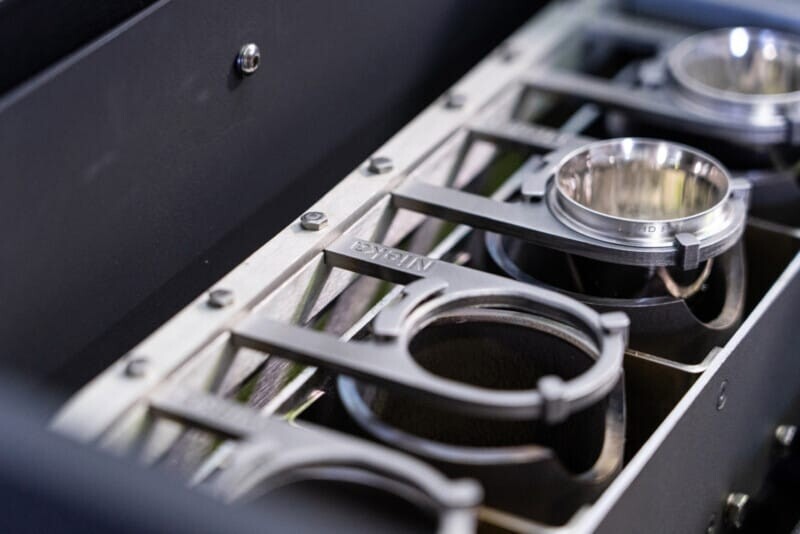
Supply chain challenge:
Initially, Nieka outsourced manufacturing of Inconel-based crucible clips to a third-party service bureau to 3D print. However, lead times were slow, highly variable, and difficult to forecast.
Nieka was a growing business: its products were available to customers in over 20 countries around the world. But due to the slow lead times and uncertainties associated with using the service bureaus, Nieka faced growing uncertainties about their ability to keep up with global demand for their products.
Supply chain solution:
Bringing additive manufacturing in-house with the Metal X system, Nieka has been able to manufacture its Inconel crucible clips in drastically reduced lead times that are consistent and predictable.
From start to finish, each batch of Inconel crucible clips can be made, and put to use, in just four days. Compared to the third party manufacturer’s average lead time of over four weeks per batch, this is an 86% reduction in lead times.
Producing each batch of the crucible clips is also ten times cheaper than the price of outsourcing their production to the third party manufacturer. Louis Croisetiere Ph.D, Founder of Nieka Systems, estimates that Nieka saves an average of $108,000 CAD per year from this application alone.

Written by Markforged
Markforged is transforming manufacturing by addressing 3D printing as a holistic problem. Their process innovations are only possible by a combined effort in advanced cloud computing, cutting-edge materials science, and industrial design.

